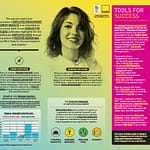As companies navigate the evolution towards remote and hybrid workspaces, relying on digital tools to keep that human connection outside of the office is mandatory.
But even for those working in an office, that feeling that they’re part of the company sometimes begins to fade. And often, a reaction from the HR office is rather late, and you’ve lost your employee’s integral interest.
What could you do to prevent this from happening, while not breaking the bank and spending thousands on training, meetings, and inefficient tools?
In this article, we will showcase the basic ways to play around with web design tools and integrate them in different ways in your working day to get the most out of your employees and boost employee engagement.
Why is Employee Engagement Important?
Motivational speaker and author, Simon Sinek said: “When people are financially invested, they want a return. When people are emotionally invested, they want to contribute.” By boosting employee engagement, you’re doing the best for your business, because you’re not just getting employees.
You’re getting fully inspired and devoted brand ambassadors. And what does this mean for your business? Let’s check out some studies and facts that cement the importance of employee engagement.
- Increased Profits: Gallup reports that businesses with highly engaged workforces enjoy 23% greater profitability, which underscores the impact that a dedicated and motivated workforce can have on a company’s bottom line.
- Better Productivity: Employee engagement is empirically linked to enhanced productivity. Studies prove that employees with a high engagement level are more efficient and effective in their roles, which leads to superior organisational performance.
- Attracting Top Talent: Who wouldn’t want to work in a positive environment where mutual support and the easy flow of daily tasks are spotless? Engaged employees speak for the company itself, and the good word travels far, attracting the best in the industry.
- Lower Turnover Rates: According to data, high turnover rates are a major cost. Consider recruiting and training new hires, while risking the possibility of them not blending in with your company. Engaged employees are committed to their organisations, their team members, and even managers, and are less likely to seek employment elsewhere.
- Improved Customer Satisfaction: Engaged employees are more likely to go above and beyond in their customer interactions, leading to improved service quality. And a satisfied customer always comes back, right? So, in the long run, engaged and satisfied employees are the foundation of your loyal customer base!
- Innovation and Creativity: According to the research conducted by Gallup, engaged employees are a key source of income. They are the ones that would most likely spot a mistake or a barrier in the working process. And logically, the ones to probably find a solution and the “easier way out”, busting up the company’s profits too.
Proven Ways to Boost Engagement With Web Design Tools
#1 Easy Navigation
Ensuring that your digital platforms are easy to navigate is crucial for maximising employee engagement. A user-friendly interface reduces frustration and saves time, allowing employees to focus on their tasks more effectively, and boosting task success rates by up to 200%.
To achieve this, consider implementing a search function or categorising content using tools like Adobe XD, or Figma (the collaborative interface tool). They both offer a range of features for creating straightforward menu structures, utilising dropdown menus, and implementing intuitive search bars with predictive text and filters.
Where to start?
- Create straightforward menu structures that categorise content logically and intuitively.
- Utilise dropdown menus or expandable sections to organise information hierarchically.
- Implement a search bar with predictive text and filters to help users find specific items.
#2 Eye-catching Imagery
Visual content has a powerful impact on engagement, capturing attention and conveying messages more effectively than plain text. According to HubSpot, articles with relevant images receive 94% more views than those without.
You should aim to incorporate high-quality images that align with your brand’s identity and values, which can enhance the overall aesthetic appeal of your digital platforms.
Tools like Adobe Stock offer a vast library of high-quality images and customisable templates, allowing you to create eye-catching visuals tailored to your brand.
Additionally, optimising image resolution and file size using Adobe Photoshop ensures fast loading times and optimal performance across devices, further enhancing the user experience.
Where to start?
- Choose images that tell a story or evoke emotion to resonate with employees on a deeper level.
- Use real and personalised brand images
- Optimise image resolution and file size to ensure fast loading times and optimal performance across devices.
#3 Expressive Icons
Icons are like the emojis of the digital world—they convey information quickly and intuitively. Choosing expressive icons that mirror your company’s vibe can inject some personality into your digital platforms.
An uprising tool called IconJar offers a treasure trove of icons to choose from, allowing you to pick and tweak ones that perfectly match your brand’s character. Remember to sprinkle these icons consistently throughout your platforms to keep things visually coherent.
Exploring the nexus of expressive icons and employee engagement reveals an intriguing insight: good design transcends mere aesthetics to forge deeper connections and enhance usability.
A memorable quote from Martin LeBlanc, “A user interface is like a joke. If you have to explain it, it’s not that good,” encapsulates the essence of intuitive design. This principle underscores the importance of creating icons that are immediately recognisable and meaningful, thereby fostering a more engaging and seamless user experience for customers, and employees too.
Where to start?
- Use icons consistently throughout your digital platforms to maintain visual coherence and familiarity.
- Incorporate tooltips or hover effects to provide additional context or information when users interact with icons.
- Regularly update and refine iconography based on user feedback and evolving design trends.
#4 Varied Fonts
Let’s talk about fonts—the basics of typography in digital communication. Playing around with different fonts and typography styles can really jazz up your messages and grab your employees’ attention instantly. Using varied fonts can boost retention rates, but readability is key for getting a clear message to your employees.
Make sure to choose fonts that are easy on the eyes, no matter the device or screen size. According to recent stats, FontAwesome is the most popular and used font for both, mobile and desktop. Luckily, there are tools like Google Fonts and Adobe Fonts that offer a smorgasbord of font options to suit every taste. So go ahead, get creative with your typography—your employees will thank you for it!
Where to start?
- Use a combination of serif and sans-serif fonts to create visual contrast and hierarchy.
- Experiment with font styles and sizes to emphasise important information and improve readability.
- Limit the number of fonts used to maintain visual consistency and avoid overwhelming users.
#5 Localised Content
Imagine your digital platforms speaking the language of your employees, quite literally. Localising websites for different regions isn’t just a nice-to-have—it’s a game-changer for engagement and market expansion, as exemplified by this IBM case study.
To kickstart your localisation efforts, consider tools like Smartling or Transifex, which offer comprehensive localisation and translation services tailored to your needs. These tools offer intuitive, native and local dialect translation, ensuring your website speaks to each employee, directly.
Moreover, you can also use project management tools on multiple channels to embrace localisation efforts! “In complex organisations, you need some way to keep everybody on the same page. When you let silos develop because there’s no organisation-wide view into what’s going on—that’s the worst possible way of working. Asana gives us a single platform across every team to share work, to communicate, and to follow up with each other,” Bill Brim, CEO of United Way of Salt Lake announced when discussing the tools offered to establish clear and purposeful brand guidelines and all the ways one could get there.
Where to start?
- Assign dedicated strategists or teams to oversee localisation.
- Develop guides and resources to streamline the localisation process and ensure consistency across regions.
- Foster collaboration and knowledge-sharing among team members to leverage their expertise.
#6 Clear Information Layout
Ever visited a website and felt instantly lost in a sea of information? That’s where a clear information layout comes into play. Organising content in a structured manner isn’t just about aesthetics—it’s about guiding users’ attention and facilitating comprehension.
Knowing that users spend 80% of their time looking at information above the fold, utilising layout techniques like whitespace, alignment, and grid systems to create visual harmony and hierarchy is a must.
And here’s a pro tip: incorporating visual cues such as color, icons, and typography can take your layout from good to great. When it comes to crafting such layouts, features like Sketch’s “Artboards” or Adobe XD’s “Repeat Grid” are invaluable.
With their powerful features, you can design clear and structured layouts with ease, keeping your users engaged and satisfied.
Where to start?
- Break up long blocks of text into shorter paragraphs or bullet points to improve readability and scanability.
- Use headings and subheadings to create logical sections and facilitate navigation within longer documents or web pages.
- Experiment with different layout formats, such as cards or grids.
#7 Consistent Design
Scrolling through different pages of a website and feeling like you’ve stumbled into entirely different universes can be disorienting! Consistency in design elements across digital platforms is like the glue that holds your brand identity together. Moreover, consistent brand presentation across all platforms can increase revenue by up to 23%.
Establishing brand guidelines that define color palettes, typography, and visual styles can help ensure that your brand speaks with one voice, no matter where your audience interacts with it. And Sketch or InVision are the right tools to start with here.
To achieve consistent design across digital platforms, utilise Figma—a collaborative interface design tool. With Figma, you can create a centralised design system containing reusable components like buttons, colors, and typography styles using features such as “Components” and “Styles”.
Collaborate with team members in real-time using features such as “Version History”, “Comments”, and “Shared Libraries”, ensuring adherence to brand guidelines and maintaining consistency throughout the design process.
Weber Shandwick’s study shows that when executives are visibly engaged on intranets, employees are 1.6 times more committed to organisational goals. Effective intranet design boosts this engagement by making the platform more interactive and user-friendly, directly showcasing leadership’s active role.
Where to start?
- Develop a comprehensive style guide that outlines design principles, standards, and best practices for internal and external use.
- Provide training and resources to team members responsible for creating or managing digital content.
- Conduct regular audits.
#8 Accessibility
So, you’re trying to navigate a website, but the buttons are so tiny you can’t tap them, and the text is too faint to read. Frustrating, right?
Designing digital platforms with accessibility in mind is crucial for ensuring inclusivity and accommodating users with diverse needs and abilities. Incorporating accessibility features such as alt text for images, keyboard navigation options, and screen reader compatibility can make a world of difference in usability.
According to Accessibly, an accessibility consultancy, approximately 15% of the world’s population has some form of disability. To address their needs, usability testing with tools like WAVE or Axe can pinpoint any barriers or areas for improvement in your digital platforms.
But accessibility also means multiple-channel accessibility. And this is something that the COVID pandemic has taught us the most, to make collaboration and work efficiency happen even on a remote basis.
Moreover, this remote accessibility also showed that workers at companies embracing remote work felt 14% more comfortable voicing their opinions and were 9% more likely to believe their leaders appreciated diverse viewpoints, compared to counterparts at non-remote-friendly firms.
The lockdown period, devoid of face-to-face interactions, prompted remote employees to value aspects like career growth, community, and inclusivity more than just their salaries.
Where to start?
- Conduct accessibility audits and usability testing to identify barriers and areas for improvement in your digital platforms.
- Provide training and resources to content creators and designers on accessibility best practices and guidelines.
#9 Feedback and Collaboration
Ever had a brilliant idea but no way to share it with your team? Or did you feel like your voice was lost in the noise? Fostering a culture of open communication and collaboration is key to driving innovation and boosting employee engagement.
By incorporating feedback tools and collaboration features into your web platforms, you empower employees to share their insights, ideas, and concerns easily. For instance, tools like Slack or Microsoft Teams offer robust features for real-time collaboration and communication.
Kevin Kruse, in “Employee Engagement 2.0,” emphasises that engagement not only enhances work life but also transforms personal lives. He introduces the concept “Great leaders Communicate GReAT,” underscoring the importance of Communication, Growth, Recognition, and Trust in fostering employee engagement. Kruse suggests that leveraging apps and software tools can accelerate manager development and boost employee engagement efficiently.
Where to start?
- Implement anonymous surveys or suggestion boxes using tools like SurveyMonkey or Google Forms to gather input from employees on various aspects of their work environment.
- Establish online forums or discussion boards using platforms like Discourse or Yammer, where employees can freely exchange ideas, ask questions, and provide feedback.
#10 Project Management Tools
Incorporating project management tools like Asana and Trello into your digital workflow is instrumental in optimising task organisation and fostering team collaboration. These tools provide a centralised platform for managing projects, enhancing transparency, and promoting accountability among team members.
According to recent research, when individual employees fully understand how their work contributes to the overall working product, and how the cycle goes, they are more engaged. Asana offers the chance for businesses to easily identify objectives and key results (OKRs). Through the new addition, “My Goals” in Asana Goals, employees can align their personal achievements with both team objectives and the broader company mission.
“This feature is easily accessible from the sidebar, ‘My Goals’, that allows you to visualise and connect your work to our collective goals, ensuring every project contributes to our shared success.” – Alex Hood, Chief Product Officer, Asana, discussed in an interview with Silicon Republic.
Where to start?
- Create project boards or task lists to outline project objectives, deadlines, and responsibilities, ensuring clarity and alignment among team members.
- Utilise task assignments, due dates, and progress tracking to monitor project milestones and ensure timely completion.
- Incorporate real-time updates, regular feedback, and discussion.
Digital Connections: A Human Endeavor
Reflecting on Matt Mullenweg’s insight, “Technology is best when it brings people together,” we amplify the necessity of web design to bring people together and motivate employees.
To get employee engagement right, we should embrace technology not just as a tool for efficiency but as a bridge to unite, inspire, and elevate our collective human spirit.
Let’s not just connect digitally; let’s create workplaces and environments that are vibrant, inclusive, and engaging.
Author: Alex Oger – Content Developer, Digital Silk
Photo credit: StockCake




